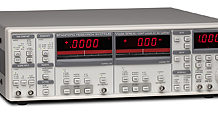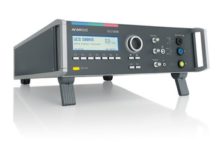The CW240 power meter is a complete tool for enhancing energy efficiency, finding areas for improvement and assessing equipment lifecycles. The meter provides in-depth information on how an item of equipment, an area of a plant or a complete facility is operating that goes beyond simply measuring power usage.
By using the supplied clamp-on components and probes, users can better determine maintenance, repair and replacement schedules for equipment such as transformers and motors. Information is provided with respect to load factors and demand factors, as well as current/voltage fluctuations at motor start-up.
The CW240 offers many unique features to improve energy efficiency through highly detailed data collection and easy-to-understand displays.
- Measurement of Instantaneous Values: Unique 3-wattmeter display provides an immediate value for each measurement element (voltage/current/electric power, etc.) to allow users to cut energy costs through a better understanding of power consumption, maximum load factor and peak current.
- Power Quality Measurement: Measures and displays active power, regenerative power and reactive power quality—along with simultaneous displays of each value.
- Demand Management: Enables users to set the desired demand limit in preferred time units in order to determine the maximum power demand.
- Harmonics Measurement: Reveals distortions in voltages and currents that can cause malfunctions and power loss. Measures harmonics from the 1st to 50th. User-friendly data display in list, bar graph (linear/log) or vector (inflow/outflow judgment).
- Waveform Measurement: Displays voltage and/or current of each phase in easy to understand graphs.
- Voltage Fluctuation Measurement: Detects time and date of each fluctuation occurrence, the fluctuation type, the rms values, and the start and end period.
Measurement of Instantaneous Values

Better determine the maintenance, repair and replacement schedules for each piece of electrical equipment, such as transformers and motors, by analyzing detailed information with respect to load and demand factors. Review detailed information on current and voltage fluctuations at motor start-up.
Measurement Elements:
- Voltage, current, electric power (active, reactive, apparent)
- Power factor, phase angle of each phase
- Average, minimum, maximum values of each measurement element
Perform data collection at intervals from 60 times per second to hourly in order to cover every application in the plant from low interval (e.g., plant watt hours) to high interval testing (e.g., troubleshooting a motor)
Data Collection Time(s):
- 1/2/5/10/15/30 seconds
- 1/2/5/10/15/30/60 minutes
- One cycle (waveform)
Power Quality Measurement
Improve power measurment and data collection for compliance with ISO14001 and other standards by showing exactly how and when power is being used. Power measurement is broken down into individual phases to provide a more comprehensive view of overall power usage.
Measurement Elements:
- Active power quantity,
- Regenerative power quantity,
- Reactive power quantity (leading/lagging)
Data Collection Time(s):
- 1/2/5/10/15/30 seconds
- 1/2/5/10/15/30/60 minutes
The CW240 also provides real-time and data log capabilities that are seamlessly downloadable into an available software package that can display graphs, trends and reports.
Select the Number of Display Digits and Units
- Standard (voltage/current range is selected by range according to the phase)
- Arbitrary (decimal point position and display unit can be specified)
- Auto (decimal point position and display unit are selected automatically according to the integration result)

Demand Management
Investigate electric power consumption rate for an item of equipment, an area of a plant or a complete facility. Get data beyond the 30-minute demand time frame that most utilities use to obtain average power usage by setting the demand time to units of seconds or minutes.
Power quality is an important and often overlooked element in reducing energy costs. If the power factor is not taken into account, an energy efficiency program could accidentally implement steps that increase the utility bill instead of lowering it. For example, replacing 100-watt incandescent bulbs with low-watt fluorescent bulbs saves energy but can worsen the power factor, possibly resulting in low power factor fines from the electric utility.
Measurement Elements:
- Maximum power demand required from the start of logging measurement and the time it occurs
- Active power, reactive (lag), power factor
- Active power quantity (consumption, regeneration), reactive power quantity (lagging/leading)
The CW240 also provides a demand feature that can be used to measure peak power usage over a specified time period. This data can be used to minimize peak power usage, or to shift peak usage to a more favorable time in accordance with electric utility time-of-day pricing.
Demand Time Setting:
- 1/2/5/10/15/30 seconds
- 1/2/5/10/15/30/60 minutes

Harmonic Measurement
Obtain detailed date to ensure a smooth power supply for operations, and prolong the life of equipment by reducing the effects of harmonics.
Inverter power supplies can cause distortions in voltages and currents, resulting in malfunctions, equipment damage and power loss. Therefore, it is critical to understand and monitor harmonics to ensure a reliable power supply. The CW240 provides displays of harmonics from the 1st to 50th for analysis to prevent problems.
Display Data:
- List, bar graph (linear/log)
- Vector (inflow/outflow judgment)
Measurement Elements:
- Level, content
- Phase angle (voltage, current, electric power of each harmonic)
- Agggregate value (voltage, current, electric power, power factor)
- Agggregate harmonic distortion factors (THD-F or THD-R) of voltage/current
THD-F
- Distortion factor for the fundamental wave, THD-R
- Distortion factor for all rms values voltage/current
Data Collection Time
- 1/2/5/10/15/30/60 minutes

Waveform Measurement
View in-depth information on waveforms through easy-to-understand graphs.
Waveform measurement provides multiple ways to measure and analyze waveforms to see large waveform distortions that can indicate a potential problem in the system.
Measurement Elements:
- Voltage of each phase
- Current of each phase
- Voltage and current of each phase
Data Saving Format:
- Binary
- Can be converted to CSV format using a standard application program

Voltage Fluctuation Management
Protect equipment from harmful power fluctuations by understanding exactly when and where these flucutuations occur.
The CW240 detects dates/times of when fluctuations occur as well as the type of fluctuation, the channels where they occur, rms values and the periods between start and end. Once the voltage threshold is set, the fluctuations exceeding the threshold are detected.
Measurement Element:
- Voltage dip (voltage drop)
- Voltage swell (voltage rise)
- Instantanreous power failure
Data Saving
- Detected based on the voltage rms value of one waveform
- Up to 100 data sets can be saved














![[AECO- Fiber Optic Sensors- Cảm biến vị trí sợi quang- Những tính năng ưu việt]](https://www.aoip.com.vn/wp-content/uploads/12-100x70.png)







Comments are closed.